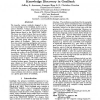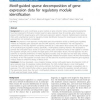820 search results - page 35 / 164 » Using Multiple Alignments to Improve Gene Prediction |
EMNLP
2009
13 years 5 months ago
2009
Current statistical machine translation systems usually extract rules from bilingual corpora annotated with 1-best alignments. They are prone to learn noisy rules due to alignment...
BMCBI
2007
13 years 7 months ago
2007
Background: Although many genomic features have been used in the prediction of proteinprotein interactions (PPIs), frequently only one is used in a computational method. After rea...
ISMB
1993
13 years 8 months ago
1993
Wedescribe various methods designed to discover knowledge in the GenBanknucleic acid sequence database. Using a grammatical model of gene structure, we create a parse tree of a ge...
BMCBI
2011
13 years 2 months ago
2011
Background: Genes work coordinately as gene modules or gene networks. Various computational approaches have been proposed to find gene modules based on gene expression data; for e...
NAR
2002
13 years 7 months ago
2002
The prediction of operons, the smallest unit of transcription in prokaryotes, is the first step towards reconstruction of a regulatory network at the whole genome level. Sequence ...


